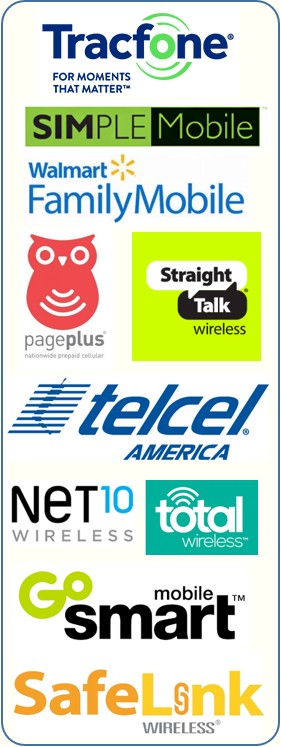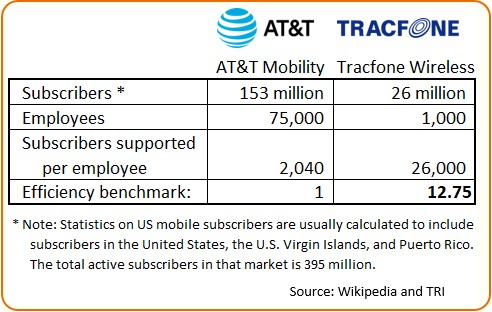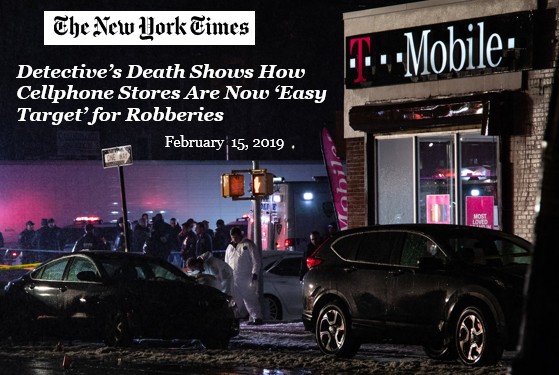| © 2022 Black Swan Telecom Journal | • | protecting and growing a robust communications business | • a service of | |
| Email a colleague |
April 2019
Tracfone’s Anti-Fraud Controls and Law Enforcement Actions to Stop Cell Phone Trafficking

Backed up by one of the best wireline, cable, and WiFi infrastructures in the world, the U.S. mobile business is a rich marketplace.
The top two U.S. mobile operators, AT&T and Verizon, are among the 50 most profitable public companies in the world . Meanwhile, the 3rd and 4th operators, T-Mobile USA and Sprint are getting set to merge to create another giant provider with 126 million subs.
But operating way outside the U.S. mobile industry limelight is a pre-paid MVNO who rides on the networks of all these larger operators and has amassed an impressive 26 million subscribers in the same U.S. market.
It’s Tracfone Wireless Inc., a subsidiary of Mexico’s largest telecom firm, América Móvil.
At the evening cocktail hour of WeDo’s Americas Conference in Fort Lauderdale (FL), I had an insightful conversation with a Tracfone executive who explained some of the key steps his firm is taking to combat fraud — and, in particular, stop cellphone trafficking.
Before we look at the company’s fraud controls and enforcement actions, it’s worth spending a few moments to discuss Tracfone’s excellent operating model and commercial success.
Tracfone: An Impressive MVNO and Retailer Partner
Most Americans know the company by its namesake brand, Tracfone Wireless, however the company also operates nine other MVNO brands seen at retail stores across the U.S. Each of these brands offer unique prepaid minute rates and support different network options:

- NET10 Wireless sells Android phones from LG and Samsung, plus unlocked iPhones. Its motto is No Bills, No Contracts, No Evil. A similar brand, Page Plus Cellular, originally operating in Ohio and Michigan, was acquired by Tracfone in 2013.
- Straight Talk has a joint-venture agreement with Walmart, its exclusive retailer, though service and phones can be bought directly from Straight Talk via its website or by phone.
- Total Wireless uses the Verizon network and features multi-line “family” plans and is available at national retailers such as Target and Dollar General.
- SafeLink Wireless serves 4 million free cellphones (with limited monthly voice minutes) to low-income families supported by America’s Universal Service Fund.
- In 2016, Tracfone acquired two MVNOs from T-Mobile USA: GoSmart Mobile and Walmart Family Mobile. However, Tracfone still operates SIMPLE Mobile as an MVNO for T-Mobile USA’s network with 2.5 million subs.
- Telcel América is an MVNO brand mainly targeted for Hispanic consumers, primarily Mexican community members living in the USA.
From the above discussion, you begin to see how Tracfone’s business acumen and efficiency has allowed it to capture the largest market share by far of independent MVNOs operating in the U.S. And it is especially strong in the retail channel.
Excellent Subscriber per Employee Efficiency
How efficient is Tracfone? Well, consider this. In 2008, Tracfone employed 400 people. If we estimate Tracfone employs 1,000 people today and compare that to the 75,000 people that AT&T Mobility employs, then you have the table below:

Comparing mobile subscriptions per employee, we estimate Tracfone is almost 13 times more efficient than AT&T Mobility. Now we know AT&T offers a far more expansive product line tailored to higher paying customers. However, considering the myriad of retailer partnering and customer-facing issues Tracfone deals with, its performance is certainly outstanding. In the billing/RA and fraud control area alone, only about 50 people are needed to get the job done.
A Simple IRSF Control Measure using 800 Numbers
When giant retailers like Walmart and Target depend on your MVNO operation, you need to carefully manage fraud and assurance issues that could easily sink your business with them.
For this reason, Tracfone oversees its international calling operation like a hawk. And they’ve worked out a clever approach for removing most of their International Revenue Share Fraud (IRSF) risk. Here are some of their key controls:
- No direct international calls — A fraudster cannot auto-program a Tracfone device to pump through calls because a connection requires a two-step process. The customer calls a designated 800 (free) number and follows recorded instructions to initiate calls to the 50-odd countries Tracfone supports.
- No international roaming is allowed — Though the Tracfone service freely roams inside the U.S. market, international roaming is blocked. And in that way, they avoid the hornet’s nest of billing delays and lack of control experienced in international roaming. What’s more, Tracfone flat-out restricts calls to cellphones in certain countries.
- Linking Up to 10 International Phone Numbers with the Subscriber
— When the customer dials the 800 number, TracFone identifies the customer’s
phone and places the call to the associated number.
By providing the phone number and serial number of the subscriber’s phone at TracFone.com, a customer can associate up to ten 800 numbers with designated phone numbers outside the U.S.
In fact, the customer could place the 800 number in his Contact List as the “phone number” of the relevant person. However, the contact info could not be copied to another phone unless the customer also registered that phone with the called number.
Tracfone sells primarily to the consumer market, so restricting speed dialing to 10 authorized foreign phone numbers is a prudent move. Yes, it’s a bit inconvenient for the subscriber, but it takes away huge headaches from fraud losses.
Cellphone Trafficking: A Financial Burden & Deadly Game
Of all the fraud issues Tracfone worries about, perhaps its biggest concern these days is stopping cell phone trafficking. In fact, the company set up a website — StopCellPhoneTrafficking.com — to educate the public and warn would-be criminals of the consequences.
Now by “trafficking” we’re not referring to the casual theft of cell phones by small-time thiefs. No, trafficking is organized crime where the objective is haul away dozens, hundreds, or thousands of devices so those phones can be unlocked, reflashed and used on some other wireless network around the world.
In the U.S., mobile phones are often heavily subsidized so the retail price the buyer pays for a phone does not reflect its true cost. The provider buries the phone’s cost in its monthly or yearly “phone service” or pre-paid top-up fees, recovering its phone investments over time.
So the criminals are raking in huge profits by the outright theft of these subsidies. In turn, wireless providers are forced to raise prices for legitimate consumers to recover their losses. Here are some facts posted on the StopCellPhoneTrafficking.com site:
- The U.S. wireless industry has lost more than $1 billion to cellphone trafficking.
- Traffickers use armed robbery, burglary, identity theft, and fraudulent schemes to get their hands on cell phones. In fact, an increase in violent street crime associated with theft of cell phones by traffickers is being reported by Law Enforcement agencies worldwide.
- Organized crime and terrorist groups are often profiting from cellphone trafficking.
- When unsuspecting customers buy trafficked “new” cell phones (often resold in counterfeit packaging) the phones often don’t work as intended anyway.
TracFone’s Aggressive Law Enforcement Campaign
Also on the website are posted about 30 news stories and 200 court documents showing the action Tracfone and other operators are taking to protect themselves and financially go after the trafficking criminals and bring them to justice.
Tracfone’s campaign to weed out cell phone trafficking began in 2006. As of the year 2012 Tracfone had filed 88 lawsuits in 12 different federal district courts across the United States. The litigation resulted in injunctions and final judgments against 205 companies and individuals. In all, Tracfone was awarded more than $305 million in judgments against international traffickers.

law enforcement perspective on the cellphone trafficking problem.
Here’s a few of the cases posted on StopCellPhoneTrafficking.com, including a fresh story from Portland, Oregan that was published in today’s news:
- Whitehall, Pennsylvania -- In 2017, Police apprehended two men who stole 79 devices, mostly phones, worth $40,000 and $400 from the cash register during an armed robbery of the store. Later, Michael Davis, an employee at the store was murdered outside his home, and the store manager was abducted and beaten.
- Brooklyn, New York — In 2016, police arrested three men and investigators seized more than 11,000 counterfeit Apple and Samsung phones, along with more than $70,000 in cash. The busts were the result of an ongoing investigation into counterfeit cellphone trafficking.
- Minneapolis, Minnesota: In 2017, three brothers were sentenced to lengthy jail times for operating an organized cell phone and mobile device trafficking operation. Kana (40), Jamal (45), and Nizar (26) Mustafa from 2006 through 2014 obtained $20 million worth of mobile devices, then sold these devices around the country and internationally.
- Miami, Florida — in 2012 TracFone scored a victory against international traffickers as U.S District Judge Jose E. Martinez entered a permanent injunction against a Hong Kong company to pay $40 million in damages to Tracfone for illegally trafficking its cell phones.
- Portland, Oregon — In early 2019, two foreign students from China were busted for making $900,000 in fraudulent Apple iPhone returns, according to federal law enforcement. They allegedly sent fake iPhones back to Apple claiming they did not work. When Apple sent a new, legitimate replacement phone, the pair would sell them to a broker — usually overseas. Both students would get a cut of the profit. It seems all of the sales were done online.
Conclusion
Both MVNOs and network operators can learn a trick or two from Tracfone. Here are two takeaways:
- The cellphones you sell are magnets for fraudsters to hijack. Use 800-numbers and other controls to limit a fraudster's ability to pump IRSF traffic.
- Violence and thieves are a fact of life. Just as a city can't function without prosecutors and police, a mobile phone business doesn't work without law enforcement. Fraudsters keep track of which operators go after criminals, so it's best to earn a reputation for hiring lawyers and investigators who send people to jail.
Copyright 2019 Black Swan Telecom Journal
Black Swan Solution Guides & Papers
- Expanding the Scope of Revenue Assurance Beyond Switch-to-Bill’s Vision — Araxxe — How Araxxe’s end-to-end revenue assurance complements switch-to-bill RA through telescope RA (external and partner data) and microscope RA (high-definition analysis of complex services like bundling and digital services).
- Lanck Telecom FMS: Voice Fraud Management as a Network Service on Demand — Lanck Telecom — A Guide to a new and unique on-demand network service enabling fraud-risky international voice traffic to be monitored (and either alerted or blocked) as that traffic is routed through a wholesaler on its way to its final destinations.
- SHAKEN / STIR Calling Number Verification & Fraud Alerting — iconectiv — SHAKEN/STIR is the telecom industry’s first step toward reviving trust in business telephony — and has recently launched in the U.S. market. This Solution Guide features commentary from technology leaders at iconetiv, a firm heavily involved in the development of SHAKEN.
- Getting Accurate, Up-to-the-Minute Phone Number Porting History & Carrier-of-Record Data to Verify Identity & Mitigate Account Takeovers — iconectiv — Learn about a recently approved risk intelligence service to receive authoritative and real-time notices of numbers being ported and changes to the carrier-of-record for specific telephone numbers.
- The Value of an Authoritative Database of Global Telephone Numbers — iconectiv — Learn about an authoritative database of allocated numbers and special number ranges in every country of the world. The expert explains how this database adds value to any FMS or fraud analyst team.
- The IPRN Database and its Use in IRSF & Wangiri Fraud Control — Yates Fraud Consulting — The IPRN Database is a powerful new tool for helping control IRSF and Wangiri frauds. The pioneer of the category explains the value and use of the IPRN Database in this 14-page Black Swan Solution Guide.
- A Real-Time Cloud Service to Protect the Enterprise PBX from IRSF Fraud — Oculeus — Learn how a new cloud-based solution developed by Oculeus, any enterprise can protect its PBX from IRSF fraud for as little as $5 a month.
- How Regulators can Lead the Fight Against International Bypass Fraud — LATRO Services — As a regulator in a country infected by SIM box fraud, what can you do to improve the situation? A white paper explains the steps you can and should you take — at the national government level — to better protect your country’s tax revenue, quality of communications, and national infrastructure.
- Telecom Identity Fraud 2020: A 36-Expert Analysis Report from TRI — TRI — TRI releases a new research report on telecom identity fraud and security. Black Swan readers can download a free Executive Summary of the Report.
- The 2021 State of Communications-Related Fraud, Identity Theft & Consumer Protection in the USA — iconectiv — This 49-page free Report on communications-related fraud analyzes the FTC’s annual Sentinel consumer fraud statistics and provides a sweeping view of trends and problem areas. It also gives a cross-industry view of the practices and systems that enable fraud control, identity verification, and security in our “zero trust” digital world.
Recent Stories
- Epsilon’s Infiny NaaS Platform Brings Global Connection, Agility & Fast Provision for IoT, Clouds & Enterprises in Southeast Asia, China & Beyond — interview with Warren Aw , Epsilon
- PCCW Global: On Leveraging Global IoT Connectivity to Create Mission Critical Use Cases for Enterprises — interview with Craig Price , PCCW Global
- Subex Explains its IoT Security Research Methods: From Malware & Coding Analysis to Distribution & Bad Actor Tracking — interview with Kiran Zachariah , Subex
- Mobile Security Leverage: MNOs to Tool up with Distributed Security Services for Globally-Connected, Mission Critical IoT — interview with Jimmy Jones , Positive Technologies
- TEOCO Brings Bottom Line Savings & Efficiency to Inter-Carrier Billing and Accounting with Machine Learning & Contract Scanning — interview with Jacob Howell , TEOCO
- PRISM Report on IPRN Trends 2020: An Analysis of the Destinations Fraudsters Use in IRSF & Wangiri Attacks — interview with Colin Yates , Yates Consulting
- Telecom Identity Fraud 2020: A 36-Expert Analyst Report on Subscription Fraud, Identity, KYC and Security — by Dan Baker , TRI
- Tackling Telecoms Subscription Fraud in a Digital World — interview with Mel Prescott & Andy Procter , FICO
- How an Energized Antifraud System with SLAs & Revenue Share is Powering Business Growth at Wholesaler iBASIS — interview with Malick Aissi , iBASIS
- Mobileum Tackles Subscription Fraud and ID Spoofing with Machine Learning that is Explainable — interview with Carlos Martins , Mobileum


